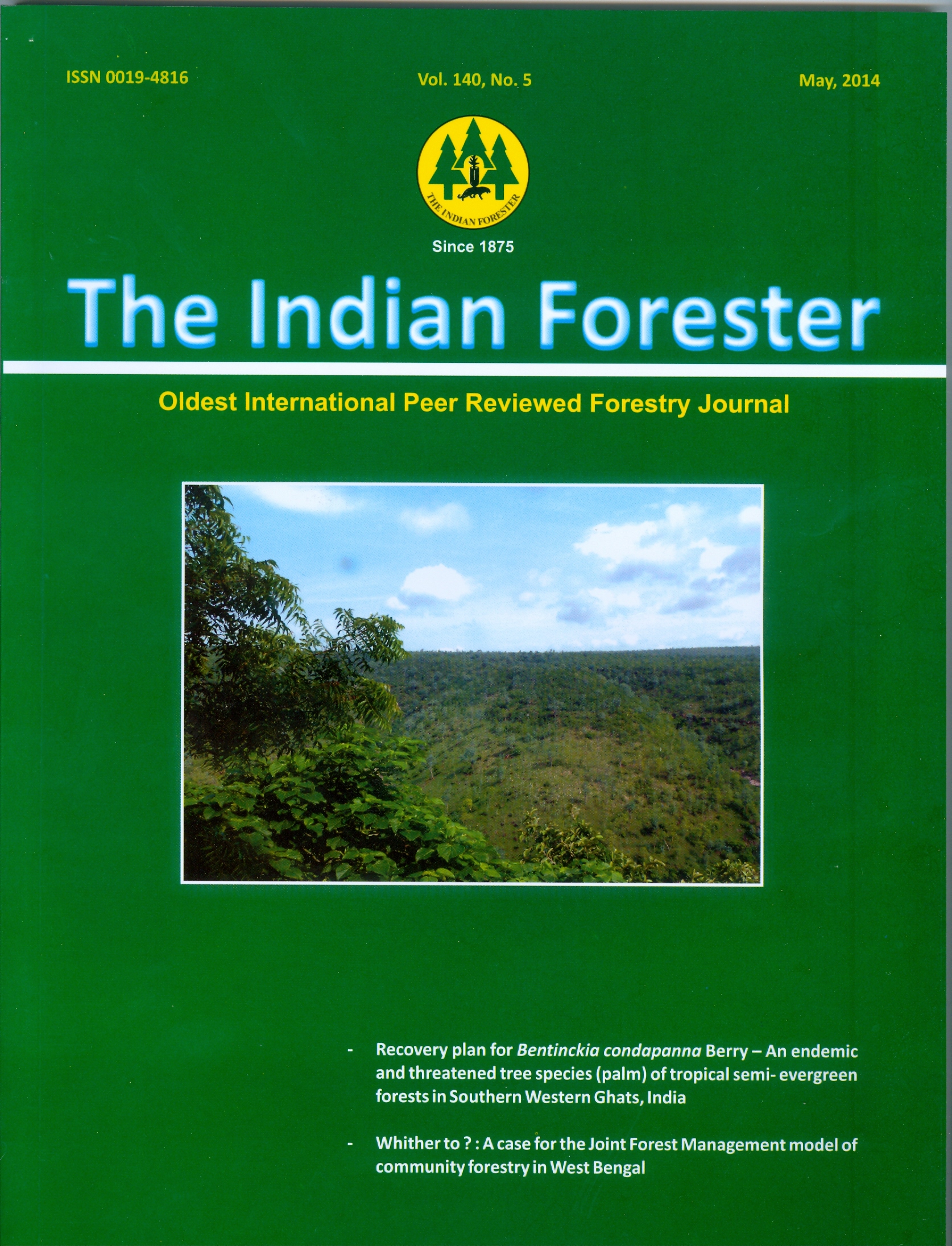Recovery Plan for Bentinckia Condapanna Berry - an Endemic and Threatened Tree Species (palm) of Tropical Semi- Evergreen forests in Southern Western Ghats, India
DOI:
https://doi.org/10.36808/if/2014/v140i5/49087Keywords:
Species Recovery Plan, Endemism, Artificial Regeneration, Bentinckia CondapannaAbstract
Bentinckia condapanna Berry is one of the endemic and threatened tree species (palm) of the Southern Western Ghats in Peninsular India. B. condapanna and B. nicobarica (Kurz) Becc. are the two species of this family enlisted as threatened species of genus Bentinckia by Botanical Survey of India during 1988. B. condapanna has narrow endemic zone of distribution in the hills of South Travancore and Tirunelveli Hills of Tamil Nadu and Kerala. The habitats of the species in Tamil Nadu particularly in Kalakad Mundanthurai Tiger Reserve were analysed using GPS, GIS and stratified random sampling techniques. Satellite remote sensing data with the aid of GIS were used for site-specific mapping of the threatened species, the status of niches with regard to its growth and degradation. The threat status of the species was reassessed. Growth habit, botanical description, silvicultural characters, ethnobotanic and other utility of the species are provided. The places of endemism, precise point-location data, the phyto-geographic parameters of the area and its phytosociological layout are illustrated. Immediate need to protect and propagate this endangered species is emphasized and its methods of artificial reproduction elaborated. Finally, Threatened Species Recovery Plan (TSRP) has been suggested to protect and promote the species using in-situand ex-situ conservation methods.References
Basu, S.K. (1998). Red Data Book of Indian Plants, Nayar, M.P. and Sastry, A.R.K. (ed), B.S.I, Calcutta. 1988, II: 32: 268.
Blatter, B.E. (1926). The Palms of British India and Ceylon, Oxford University Press. Bombay, 1926, 375,pp 600.
Champion, G.H. and Seth, S.K. (1968). Forest Types of Southern India, Government Press, Forest Research Institute, Dehradun, xiii+402pp
Kerry, S. and Gillett Harriet J. (ed). (1997). IUCN Red List of Threatened Plants, IUCN –The World conservation Union, 1998. Appn. lii 862.
Koppen, W. (1954). An Introduction to climate (G.T. Trewartha Bd.) Mc Graw- Hill Book Company, 381, pp 395.
IUCN, (2001). IUCN Red List Categories, version 3.1, prepared by the IUCN Species Survival Commission) (International Union for Conservation of Nature and natural Products). Gland, Swizterland. 2001.
Lushington, A.W. (1915). Vernacular list of trees, shrubs and woody climbers in the Madras Presidency. Govt. Press, Madras. Vol. II D, 771 :601-828.
Nayar, M.P. (1996). Hotspots of Endemic Plants of India, Nepal and Bhutan. TBGRI. Trivandrum, 11 p. 252.
Pascal, J.P.(1988). Wet Evergreen Forests of the Western Ghats of India, French Institute of Pondichery. 220, 222 : 345.
Ramesh, B.R. and Pascal, J.P. (1997). Atlas of ENDEMICS of the Western Ghats (India), French Institute of Pondichery, , 89 : 403.
Sarkar, M.K. (1999). Plant survey of Endangered species in Western Ghat area along Hanumannadi, Tirunelveli Division, Tamil Nadu. News letter, Tamil Nadu Forest Department.
Sarkar, M.K. (2005). A Framework for Strategic Management of Medicinal Plants Indian Institute of Management, Bangalore; Management Review, 17 (4):133
Sarkar, M.K. (2010). “Conservation and management strategies for endemic and threatened medicinal plants in Kalakad Mundanthurai Tiger Reserve (KMTR), Southern Western Ghats of Tamil Nadu, India – A Geoinformatic Approach; Ph D Thesis. St. Joseph's College, Bharathidasan University, Tiruchirapalli, Tamil Nadu, INDIA, 182-187, ix+240pp.
Sarkar, M.K. (2012). “Management Strategies for Endemic and Threatened Medicinal Plants in India – A Geoinformatic Approach†Department of Environment, Government of Tamil Nadu, Chennai, INDIA, 363-364 ix+1-596pp
Surveyor, General of India (1969, 1978). Survey of India Maps No 58 H/1, 58 H/2 , 58 H/5, 58 H/6, 58 H/7, 58 H/10 and 58 H/11; Kerala, Tamil Nadu ;First edition (1:50,000)
Varghese, A.O. and Krishna Murthy, Y.V.N (2006). Application of geoinformatics for conservation and management of rare and threatened plant species, Current Science, 91(6). 731-850.
Ved, D.K. (2000). List of Medicinal Plants in TamilNadu, Foundation for Revitalisation of Local Health Traditions (FRLHT), Bangalore,
WCMC, (1992). Global Biodiversity(World Conservation Monitoring Centre)Chapman Hall. London.
WCMC, (1996). INDIA– all Nationally Threatened Taxa listed at WCMC, Conservation status listing of plants. pp.1-145 World Conservation Monitoring Centre, Huntingdon Road, Cambridge. United Kingdom.
Downloads
Downloads
Published
How to Cite
Issue
Section
License
Unless otherwise stated, copyright or similar rights in all materials presented on the site, including graphical images, are owned by Indian Forester.





